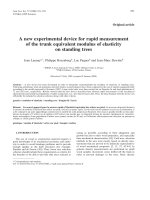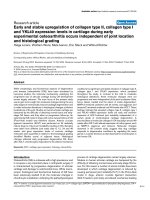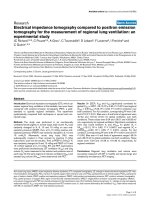experimental report physics i experimental report 1 measurement of basic length
Bạn đang xem bản rút gọn của tài liệu. Xem và tải ngay bản đầy đủ của tài liệu tại đây (7.67 MB, 41 trang )
<span class="text_page_counter">Trang 1</span><div class="page_container" data-page="1">
<b>HANOI UNIVERSITY OF SCIENCE AND TECHNOLOGY</b>
SCHOOL OF ENGINEERING PHYSICS---- ----
<b>EXPERIMENTAL REPORT</b>
<b>PHYSICS I</b>
- Experiment Teacher: Đặng Đức Dũng- Student:
+ Name: Nguyễn Đức Minh Tuấn + ID: 20215772+ Class: 716761 + Group: 6
<b> HÀ NỘI, NĂM 2022</b>
</div><span class="text_page_counter">Trang 2</span><div class="page_container" data-page="2"><b>Experimental report 1: MEASUREMENT OF BASIC LENGTH</b>
- Name: Nguyễn Đức Minh Tuấn – ID: 20215772- Group: 6
- Class: 716761
<b>1. Experimental purpose:</b>
- Knowing how to use the Vernier Caliper and Micrometer properly- Measuring some parameters of a metal hollow cylinder and a small steel ball- Calculate the volume and density of the metal hollow cylinder
- Calculate the volume of the steel ball
<b>2. Theoretical basis:2.1. Vernier Caliper:</b>
- To read result with a vernier caliper, we need to use this equation:D = n.a + m.∆ (mm)+ n is the number of divisions on the main rule + m is the number of divisions on the vernier scale + a is the value of a division on main rule+ ∆ is the vernier precision, ∆ = 1/N
<b>2.2. Micrometer:</b>
- To read result with a micrometer, following equations:
D = n.a + m.∆ (mm) (1) or D = n.a + m.∆ +0,5 (mm) (2)+ n is the number of divisions on the sleeve (top half)
+ m is the number of divisions on thimble except the 0-mark+ a is the value of a division on sleeve- main rule
</div><span class="text_page_counter">Trang 3</span><div class="page_container" data-page="3">+ ∆ is the vernier precision and corresponding to the value of division on thimble
* Note:
- If the distance between thimble and line on top half of main rule is closer than bottom half then we use (1)
- If the distance between thimble and line on bottom half is closer than top then we use (2)
<b>2.3. Calculation of volume (V) and density (p):2.3.1. Metal hollow cylinder:</b>
- Volume:
=
V ( D<small>2</small> - d <small>2</small>). h+ D is external diameter of metal hollow cylinder+ d is internal diameter of metal hollow cylinder+ h is the height of metal hollow cylinder- Density:
= + m is mass of metal hollow cylinder
+ V is volume of metal hollow cylinder
<b>2.3.2. Steel ball:</b>
- Volume:
= π.+ D is diameter of the steel ball<small>b</small>
<b>3. Experimental sequence:</b>
</div><span class="text_page_counter">Trang 4</span><div class="page_container" data-page="4">- Step 1: prepare a vernier Caliper, a micrometer, a metal hollow cylinder, and a steel ball- Step 2: use vernier Caliper to measure the height, the external diameter, and the internal diameter of metal hollow cylinder 5 times
- Step 3: use micrometer to measure the diameter of the steel ball 5 times
- Step 4: write down all the measurement results on tables and process the measurement data
<b>4. Experimental result:4.1 Hollow cylinder:</b>
</div><span class="text_page_counter">Trang 5</span><div class="page_container" data-page="5"><b>5.1. Calculation average and uncertainties: a. For the Metal hollow cylinder: </b>
43.71 (mm) 35.12 (mm) 8.21 (mm)
/)
<b>b. For the steel ball</b>
= = Hence:
</div><span class="text_page_counter">Trang 6</span><div class="page_container" data-page="6">V= (4.37 0.02)
=> Hence:
p = (8.03) ()
<b>b. For the steel ball:</b>
=> Hence:
<b>Experimental report 2: MOMENTUM AND KINETIC INELASTIC AND INELASTIC COLLISIONS</b>
- Name: Nguyễn Đức Minh Tuấn – ID: 20215772- Group: 6
</div><span class="text_page_counter">Trang 7</span><div class="page_container" data-page="7">+) inelastic collision: δ = 0 Hence:
</div><span class="text_page_counter">Trang 8</span><div class="page_container" data-page="8"><b>3. Experimental sequence:3.1. Elastic collision:</b>
- Step 1: Place the cart 1 (m ) on the left of track closer to the starter system. The cart (m ) is<small>12</small>
stationary between the photogates
-Step 2: Push the trigger on the top of vertically long term of the starter system that enables cart 1 to be released and accelerate in the direction to cart 2
-Step 3: After collision, cart 2 moves with the velocity v ’ that can be calculated by duration t ’ <small>22</small>
measured by photogate 2 and cart 1 moves in the opposite direction with cart 1. Then, record the time t ’ and total time t<small>21</small>+t<small>1</small>’ displayed on the timer
-Step 4: Repeat the measurement procedure from step 1 to 3 for more 9 times and record all the measurement results in a data sheet 1
-Step 5: Weight two carts to know their masses by using an electronic balance. Record the mass of each cart
<b>3.2. Inelastic collision:</b>
-Step 1: Place the cart 1 (m ) on the left of track closer to the starter system. Place cart 2 (m ) <small>12</small>
also stationary between the photogates
-Step 2: Push the trigger of the starter system. Record the moving time t<small>1</small>
-Step 3: After collision, record the t’ displayed on the timer
-Step 4: Repeat the measurement procedure from step 1 to 3 for more 9 times. Record all the measurement results
-Step 5: Weight two carts to know their masses. Record the mass of each cart
</div><span class="text_page_counter">Trang 10</span><div class="page_container" data-page="10">* Note: after measurements, we have t t<small>12</small>which is different from the theory. This happens due to friction force on the track
<b>5. Data processing:5.1. Elastic collision:</b>
<b>a. Velocity:</b>
<b>b. Momentum:</b>
Take the +x-direction coincides with direction of motion of cart 1. The total momentum before collision:
Hence
</div><span class="text_page_counter">Trang 11</span><div class="page_container" data-page="11"> The total momentum after collision:
Hence
The percent change of momentum is=
* In conclusion: This difference is acceptable because during the measurement of force, the handpresses the start button unevenly and accidentally exerts force on the table, causing theAluminum demonstration track to vibrate.
<b>c. Kinetic:</b>
+) Before collision Hence
+) After collision
</div><span class="text_page_counter">Trang 12</span><div class="page_container" data-page="12">
Hence
+) The percent change in kinetic energy
* In conclusion: we can notice that the kinetic energy after an elastic collision is insignificantly less than that one occurring before.
<b>5.2 Inelastic collision:</b>
<b>a. Velocity:</b>
<b>b. Momentum:</b>
Take the + x-direction coincides with direction of motion of cart 1. The total momentum before collision:
Hence
</div><span class="text_page_counter">Trang 13</span><div class="page_container" data-page="13">Hence
The percent change of momentum is
* In conclusion: This difference is acceptable because during the measurement of force, the handpresses the start button unevenly and accidentally exerts force on the table, causing the Aluminum demonstration track to vibrate.
</div><span class="text_page_counter">Trang 14</span><div class="page_container" data-page="14">+) The percent change of kinetic energy is
=> It is obviously that the kinetic energy after a completely inelastic collision is always lessthan before
<b>Experimental report 3: MOMENT OF INERTIA OF THESYMMETRIC RIGID BODIES</b>
- Name: Nguyễn Đức Minh Tuấn – ID: 20215772- Group: 6
- Class: 716761
<b>1. Experimental purposes: </b>
- Calculating the moment of the inertia in the symmetric rigid bodies
- Gaining knowledge about the moment of the inertia in the symmetric rigid bodies
</div><span class="text_page_counter">Trang 15</span><div class="page_container" data-page="15">- If the axis of rotation is chosen to be through the center of mass of the object, then the moment of inertia about the center of mass axis if call I . <small>cm</small>
+For a long bar: I =<small>cm </small>
+For a thin disk or a solid cylinder: I = mR<small>cm </small> <sup>2</sup>
+For a hollow cylinder having very thin wall: I = mR<small>cm </small> <sup>2</sup>
+For a solid sphere: I<small>cm </small>=mR<small>2</small>
- The parallel-axis theorem relates the moment of inertia Icm about an axis through the center of mass to the moment of inertia I about a parallel axis through some other point
I = I + Md<small>cm</small> <sup>2</sup>
- The object whose moment of inertia is to be measured can be mounted on the axis of this torsion spring which tends to restrict the rotary motion of the object and provides a restoring torque. If the object is rotated by an angle ø, the torque acting on it will be
τ = D ø<small>zz.</small> (D is an elastic constant of spring)<small>z</small>
- This torque will make the object oscillation. Using the theorem of angular momentum of a rigidbody in rotary motion.
τ = = I = I - We get the typical equation of oscillation as - The oscillation is corresponding to a period
T = 2π =>
For a known D , the unknown moment of inertia of an object can be found if the period T is <small>z</small>
<b>3. Experimental sequence:3.1. Measurement of the rod:</b>
- Step 1: Equipment is setup corresponding to instruction. A mask is stuck on the rod to ensure the rod went through the photogate
- Step 2: Press the button “Start” to turn on the counter
- Step 3: Push the rod to rotate with an angle of 180. You got the averaged result after several periods
- Step 4: Press the button “Reset”. Uninstall the rod for next measurement
<b>3.2. Measurement of the solid disk:</b>
- Step 1: Using the suitable screws to mount the solid disk on the rotation axle of the spiral spring
</div><span class="text_page_counter">Trang 16</span><div class="page_container" data-page="16">- Step 2: Perform the measurement procedure similar to that of the rod. Record the measurement result of period T in a data sheet.
- Step 3: Press the button “Reset” to turn the display of the counter being 0. Uninstall the disk
<b>3.3. Measurement of the hollow cylinder:</b>
- Step 1: Using the suitable screws to mount the hollow cylinder coupled with a supported disk below on the rotation axle of the spiral spring. A piece of note paper is also stuck on the disk to ensure the system passing through the photogate
- Step 2: Perform the measurement procedure similar to that of the disk. Record the measurementresult of period T in data sheet
- Step 3: Push the button reset to turn the display of the counter being 0. Uninstall the hollow cylinder and repeat the measurement to get its rotary period T
- Step 4: Press the button “Reset” to turn the display of the counter being 0. Uninstall the supported disk for next measurement
<b>3.4. Measurement of the solid sphere:</b>
- Step 1: Mount the solid sphere on the rotation axle of the spiral spring. Apiece of note paper is also stuck on the sphere to ensure its passing through the photogate
- Step 2: Push the sphere to rotate with an angle of 270. Record vibrationi period of the sphere- Step 3: Uninstall the solid sphere and switch off the counter. Finish the measurements
<b>4. Experimental results:4.1. Measurement of the rod:</b>
L = 0.620 mm = 0.240 kg
Trial T<small>1</small> (s)1 2.6512 2.6473 2.6454 2.6495 2.644
<b>4.2. Measurement of the solid disk:</b>
m = 0.795 kgd = 0.220 m
</div><span class="text_page_counter">Trang 17</span><div class="page_container" data-page="17">Trial T<small>2</small> (s)1 2.1082 2.1093 2.1074 2.1155 2.098
<b>4.3. Measurement of the hollow cylinder:4.3.1. Supported disk:</b>
Trial T<small>3</small> (s)1 0.3202 0.3273 0.3264 0.3245 0.323
<b>4.3.2. Supported disk and Hollow cylinder:</b>
m<small>(cy)</small> = 0.780 kgd<small>(cy)</small> = 0.089 m
Trial T<small>4</small> (s)1 1.1402 1.1413 1.1424 1.1435 1.141
<b>4.4. Measurement of solid sphere:</b>
m = 2.290 kgd = 0.146 m
Trial T<small>5</small> (s)1 2.1192 2.1123 2.1204 2.1275 2.113
<b>5.Processing of measurement data:</b>
<b>5.1. The average value of the vibration periods of corresponding bodies:</b>
</div><span class="text_page_counter">Trang 18</span><div class="page_container" data-page="18">- The rod: +
- The solid disk: +
- The supported disk: +
- The supported disk + hollow cylinder: +
- The solid sphere: +
<b>5.2. The rod:</b>
a. Moment of inertia obtained by experiment:+
+ Hence
b. Moment of inertia obtained by theoretical formula:+
=> The difference between theoretical and experimental value:
<b>5.3. The solid disk:</b>
a. Moment of inertia obtained by experiment:+
+ Hence
</div><span class="text_page_counter">Trang 19</span><div class="page_container" data-page="19">b. Moment of inertia obtained by theoretical formula:+
=> The difference between theoretical and experimental value:
<b>5.3. The hollow cylinder:</b>
a. Moment of inertia obtained by experiment:+) Moment of inertia of the supported disk:+
+ Hence
+) Moment of inertia of the coupled object (supported disk + hollow cylinder): +
+ Hence
=> Moment of inertia of the hollow cylinder:+
</div><span class="text_page_counter">Trang 20</span><div class="page_container" data-page="20"><b>5.4. The solid sphere:</b>
a. Moment of inertia obtained by experiment:+
+ Hence
b. Moment of inertia obtained by theoretical formula:+
=> The difference between theoretical and experimental value:
</div><span class="text_page_counter">Trang 21</span><div class="page_container" data-page="21"><b>Experimental report 4: PENDULUM OSCILLATION WITH PCINTERFACE</b>
- Name: Nguyễn Đức Minh Tuấn – ID: 20215773- Group: 6
- Class: 716761
<b>1. Experimental purpose:</b>
- Understanding more about the harmonic oscillation - Verifying the value of gravity acceleration- Improving experimental skills
- This is a harmonic oscillation having the amplitude and the oscillation period T<small>0</small>
- If one rotates the oscillation plane around the angle with respect to the vertical plane, thecomponents of acceleration of gravity g() which are effective in its oscillation plane are reducedto g() = g.cos , that is only the force component is effective and the following is obtained for theoscillation period:
<b>3. Experimental sequence:</b>
<b>3.1. Oscillation of pendulum in vertical plane with various pendulum lengths:- Step 1: Choose an arbitrary pendulum length. Note that the pendulum length</b>
<b>- Step 2: Move the 1-g weight holder. Set the pendulum in motion and click on the “Start</b>
measurement” icon. Determine the period duration with the aid of the cursor lines
</div><span class="text_page_counter">Trang 22</span><div class="page_container" data-page="22"><b>- Step 3: Repeat the measurement several times to get the average value of the oscillation period- Step 4: Repeat the measurement with different pendulum lengths</b>
<b>3.2. Oscillation of pendulum in inclined plane with various deflection angles:- Step 1: Choose an arbitrary deflection angle. Note that the deflection angle</b>
<b>- Step 2: Set the pendulum in motion and click on the “Start measurement” icon. Determine g for</b>
various deflection angles
- Step 3: Perform the measurement several times to get the average value of oscillation period- Step 4: Repeat the measurement with different deflection angles
T<small>1</small> (s) T (s)<small>2</small> T (s)<small>3</small>
</div><span class="text_page_counter">Trang 23</span><div class="page_container" data-page="23"><b>5. Processing of measurement data:</b>
<b>5.1. Oscillation of pendulum in vertical plane with various pendulum lengths:</b>
- The oscillation period of a thread pendulum as a function of the pendulum length: a. L = 300 (mm)
</div><span class="text_page_counter">Trang 24</span><div class="page_container" data-page="24">b. L = 400 mm <small>2</small>
Hence
</div><span class="text_page_counter">Trang 25</span><div class="page_container" data-page="25">c. L = 500 mm <small>3</small>
Hence
</div><span class="text_page_counter">Trang 26</span><div class="page_container" data-page="26"><b>5.2. Oscillation of pendulum in inclined plane with various deflection angles:</b>
- The gravitational acceleration as a function of the inclination of the pendulum force: T = 2π ⟹ =
a.
Hence
</div><span class="text_page_counter">Trang 27</span><div class="page_container" data-page="27">b.
Hence
</div><span class="text_page_counter">Trang 28</span><div class="page_container" data-page="28">c.
Hence
</div><span class="text_page_counter">Trang 29</span><div class="page_container" data-page="29">d.
Hence
</div><span class="text_page_counter">Trang 30</span><div class="page_container" data-page="30">e.
Hence
</div><span class="text_page_counter">Trang 31</span><div class="page_container" data-page="31">f.
Hence
</div><span class="text_page_counter">Trang 33</span><div class="page_container" data-page="33"><b>Experimental report 5: DETERMINATION OF MOMENT OFINERTIA BASED ON TORSIONAL VIBRATION</b>
- Name: Nguyễn Đức Minh Tuấn – ID: 20215772- Group: 6
- Class: 716761
<b>1. Experimental purpose:</b>
- Verifying the linear relationship between torque and deflected angle - Understanding about the moment of inertia, torsion and modulus- Showing the torsion modulus and its uncertainty
- Showing the moment of inertia of the long rod
<b>2. Theoretical basis:</b>
- If a body is regarded as a continuum, and if and denote the position vector of a point P in the undeformed and denoted states of the body, then for small displacement vectors:
and the deformation tensor is:
- The forces are described by the stress tensor :
Hooke’s law provides the relationship between and : = E. , where E is elastic modulus - The angular restoring torque or torsion modulus D can be determined by: <small></small>
= D<small>z .</small>.- We obtain the equation of vibration as follows: - The period of this vibration is:
The linear relationship between and allows to determine D and consequently the moment <small>z </small> <small>.</small>
of inertia of the long rod
<b>3. Experimental sequence:</b>
- Step 1: Assemble the steel rod on the torsion apparatus
- Step 2: Use the spring balance of force to turn the disk being deflected an angle - Step 3: Record the value of force F shown on the spring balance and the distance of the lever arm
- Step 4: Pull out to turn the disk being deflected an angle , then let it vibration and use the stopwatch to determine the vibration period
<b>4. Experimental results: 4.1. Measurement of force (F)</b>
Trial r (m) F (N) = F.r (N.m)1
</div><span class="text_page_counter">Trang 34</span><div class="page_container" data-page="34">5 0.75 0.075
Trial r (m) F (N) = F.r (N.m)1
</div><span class="text_page_counter">Trang 35</span><div class="page_container" data-page="35"><b>5. Processing of measurement data:</b>
<b>5.1. Graph showing the relationship of torsion on deflection angle :</b>
<b>Determination of the torsion modulus (based on the graph):</b>
- Using the above graph, we can see that the “best fit” line passes through the points ( ; 0.071) and ( ; 0.193)
- We can now measure the line that has the highest slope and the lowest slope that pass through or near the error bars
</div><span class="text_page_counter">Trang 36</span><div class="page_container" data-page="36">+ The highest possible slope is
+ The lowest possible slope is
<b>5.3. Calculation of the moment of inertia of the long rod:</b>
- Calculation of average value and absolute error of T:
- We have:
Hence
<b>Experimental report 6: DETERMINATION OF SOUNDWAVELENGTH AND VELOCITY USING STANDING WAVE</b>
- Name: Nguyễn Đức Minh Tuấn – ID: 20215772- Group: 6
</div>








